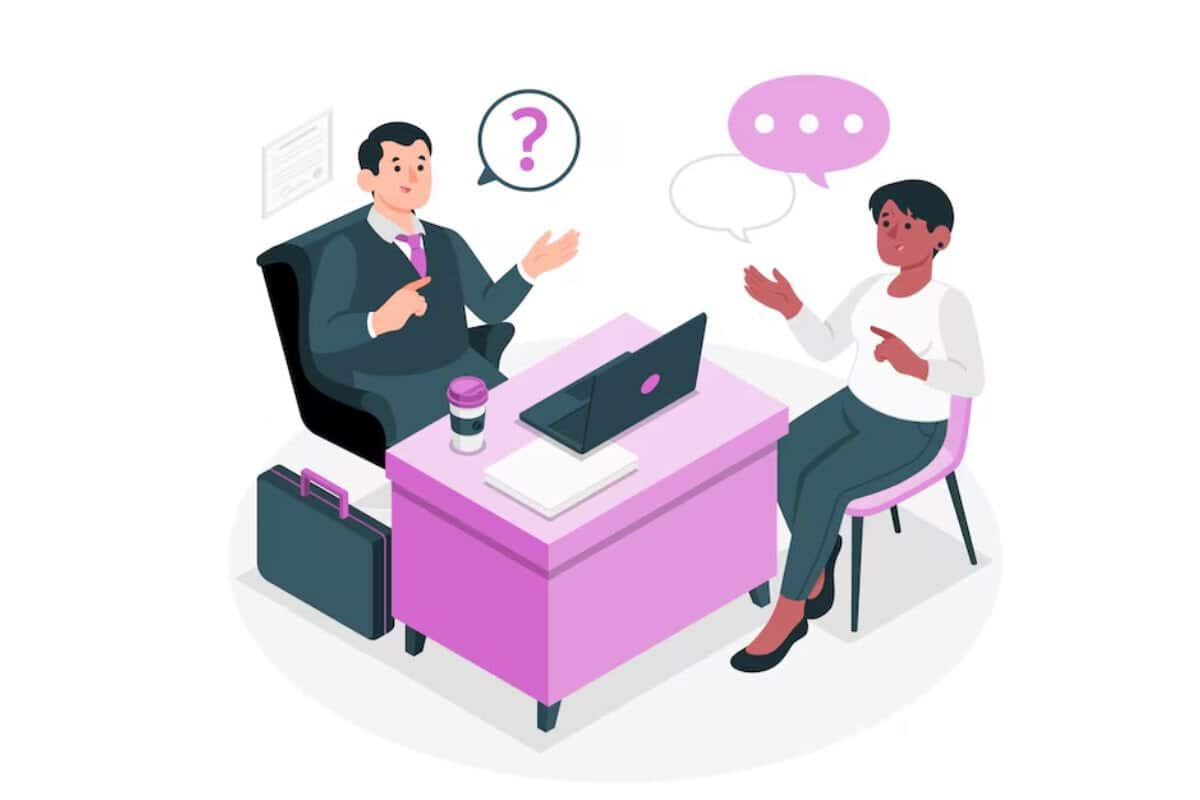Just when the interview is going smoothly—the hiring manager asks:
“What’s your greatest weakness?”
Your mind races, and you’re probably wondering: “What am I supposed to say in response to this?”
Say the wrong thing, and you risk sounding incompetent.
Give a cliché answer, and they’ll see right through it.
So, what’s the right way to respond?
The right way to respond is understanding why the employers ask this question in the first place.
In this blog, you’ll learn how to give the perfect “weaknesses” answers in an interview with winning examples.
Why Employers Ask About Weaknesses in a Job Interview
The question isn’t asked to make you uncomfortable (even though it often does).
Recruiters are looking for these three things in your answer:
- Do you have self-awareness or emotional intelligence?
- Do you have a growth mindset or learning attitude?
- Can you do a risk assessment or a role fit?
If you check all these three boxes, recruiters see you as a mature, self-aware professional.
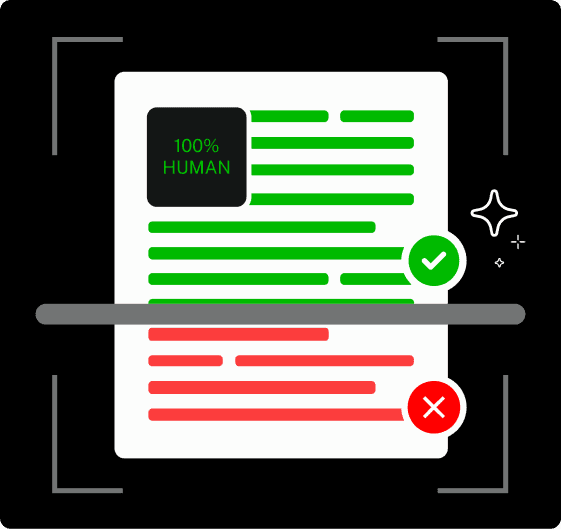
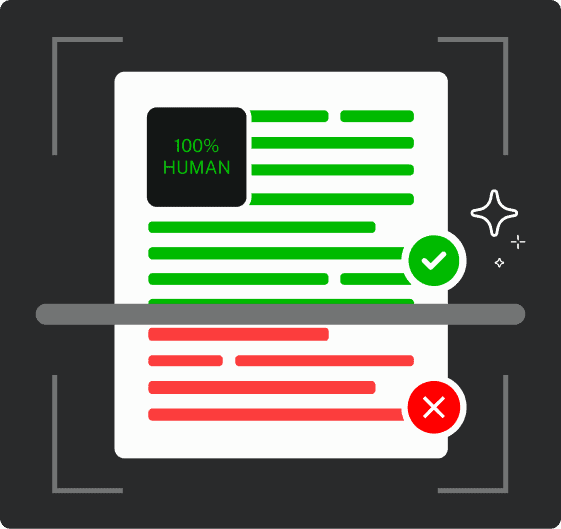
Never Worry About AI Detecting Your Texts Again. Undetectable AI Can Help You:
- Make your AI assisted writing appear human-like.
- Bypass all major AI detection tools with just one click.
- Use AI safely and confidently in school and work.
They see you as someone who understands their own development needs and can manage potential challenges in the role.
What Interviewers Want to Hear (And What to Avoid)
As mentioned earlier, recruiters judge your response based on three key factors.
To write a strong answer, ensure your weakness:
- Is genuine but not critical to the job
- Focuses on a skill you’re actively improving
- Demonstrates a solution-oriented mindset
Example: I’ve found that I sometimes hesitate to speak up in large group settings, particularly when I have a different perspective. To address this, I’ve started practicing the ‘two-minute rule’ – if I have a thought that could add value and haven’t spoken for two minutes, I contribute. I’ve also been taking an assertiveness training course. These strategies have helped me become more confident in sharing my insights, though I’m still working on it.
Such an answer is genuine, focuses on a skill you’re improving (implementing the two-minute rule) and shows your solution-oriented mindset (training course).
However, candidates mention such weaknesses which hurt their chances instead of helping them.
That’s why, it’s just as important to know what to avoid in an interview.
Avoid these answers:
- Mentioning Crucial Job Skill
For example,
If you’re applying for a sales position, don’t say you’re bad at negotiating
For a management role, avoid mentioning difficulties with delegation or team leadership
- Using Cliché Responses
For example,
I’m a perfectionist, I work too hard or I’m too dedicated to my work, all such answers don’t show self-awareness.
- Sharing Weaknesses That Are Red Flags
For example,
Don’t mention issues like punctuality, deadlines, or basic professional conduct.
Avoid interpersonal weaknesses like “I don’t work well with others”
All of these answers show that you’re either not a team-fit or difficult to be collaborated with.
How to Answer Without Hurting Your Chances
Use these top two ways to answer this tricky question.
# 1 – Use the “Past-Progress-Present” Framework
Past: “In my previous role, I noticed…”
Progress: “I took specific steps to address this by…”
Present: “Now, I’ve developed a system where…”
For Example: In my previous role, I was spending too much time writing perfect emails. I took specific steps to address this by creating email templates for common situations and setting time limits for email composition. Now, I’ve developed a system where I batch-process emails twice a day and use the two-minute rule – if it takes less than two minutes, I handle it immediately.
- Choose Strategic Weaknesses
Choose a weakness which shows growth potential. Strong options are:
- Technical skills that are easily learnable
- Processes that can be systematized
- Soft skills that show growth potential
For Example: I realized I needed to strengthen my data visualization skills. I enrolled in an advanced Excel course, completed three Tableau certifications, and now regularly create dashboards for my team. This has turned into a strength, as I’m now the go-to person for creating compelling data presentations.
By framing your response this way, you highlight self-awareness, initiative and a commitment to growth – without hurting your chances.
How to Structure Your Answer to “What Are Your Weaknesses?
A well-structured answer that scores 10/10 is concise and growth-focused. That’s where the POWER structure comes in.
P – Present the Weakness
O – Outline the Impact
W – What You’re Doing About It
E – Evidence of Improvement
R – Relate to the Role
Let’s break this down.
Step 1: Choose a Real (But Manageable) Weakness
P – Present the Weakness (10-15 seconds)
Pick a work-related weakness that isn’t essential to your role. Show honesty and professionalism.
Example: I take too many projects at once.
O – Outline the Impact (10-15 seconds)
Show that you’re self-aware by briefly explaining how this weakness has affected your work.
Example: I noticed that juggling too many tasks reduced my ability to give each project the deep focus it deserved.
Step 2: Show How You’re Actively Improving It
W – What You’re Doing About It (20-25 seconds)
Explain specific actions you’re taking to improve.
Example: Over the past six months, I’ve implemented a project management system using Asana, where I track all commitments.
E – Evidence of Improvement (15-20 seconds)
Use numbers or examples to prove that you’ve improved.
Example: This system is now helping me complete 23% more projects on time in the last quarter. My project satisfaction scores have also increased from 7.8 to 9.2.
Step 3: Keep It Honest Without Being Self-Destructive
Avoid doing self-deprecation when discussing your weaknesses.
Mention growth and solutions rather than criticizing yourself too much.
For example,
Bad: I’m terrible at time management.
Good: I’m improving my time management by using a new project management system.
You can also get help from AI Chat by Undetectable AI to structure your response.
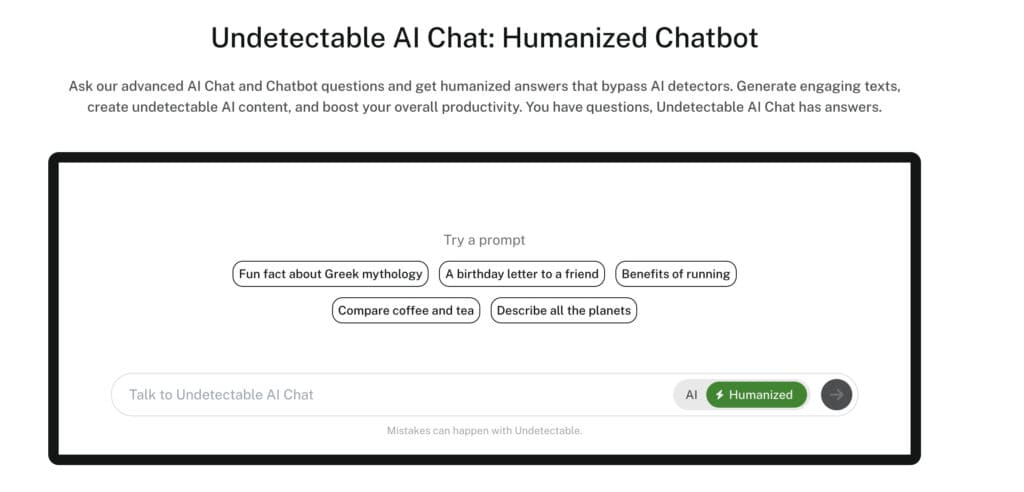
- Identify a Weakness: Ask AI for relevant and manageable weaknesses based on your role.
- Check Your Tone: Ask AI if your answer sounds honest and not self-critical.
- Improve Focus: Request AI to make your response sound more solution-oriented.
Step 4: End on a Positive Note
R – Relate to the Role (10-15 seconds)
Show how this improvement will benefit your future work.
Example: I’m excited to bring this structured approach to this role, especially given the cross-functional nature of the projects here.
10 Best Weaknesses Answers for Job Interviews (With Examples)
The key is to mention a weakness and show how you’re actively improving it.
Below, we’ve compiled 10 of the best weakness answers (with examples) to help you give a direction on how you can answer this question professionally.
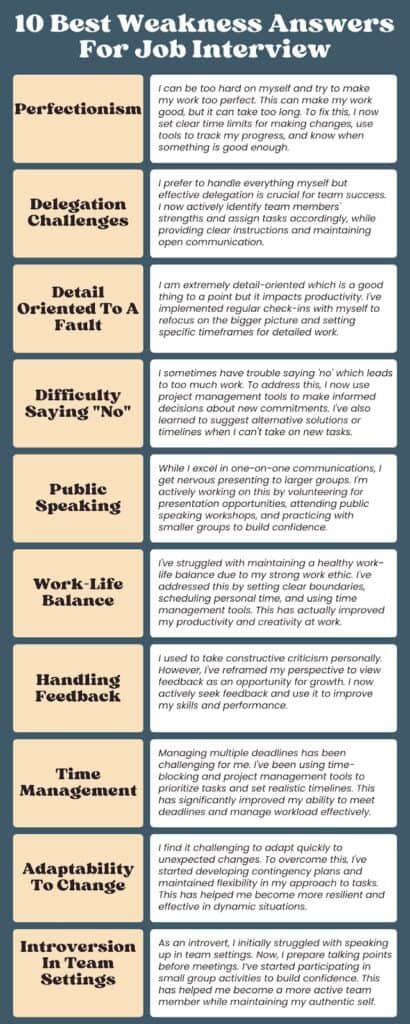
Common Mistakes to Avoid When Talking About Weaknesses
We all have weaknesses – Yes, even the hiring manager!
But the way you talk about them can make or break your answer.
Avoid these classic blunders to come across as self-aware, growth-minded and confident.
Choosing a Weakness That’s a Red Flag for the Role
A major mistake is picking a weakness that directly impacts the core responsibilities of the job.
Example:
If applying for a data analyst position:
✓ OK to mention: Public speaking anxiety (since it’s not a core requirement)
✗ Avoid: I sometimes make calculation errors (this is a red flag for the role)
Being Too Generic or Using a Cliché Answer
Using well-worn, generic weaknesses like “I’m a perfectionist” or “I work too hard.”
These responses lack depth and don’t convey genuine self-awareness.
Interviewers have heard these clichés countless times, and they don’t give you a chance to stand out.
Example
Instead of: I’m a perfectionist
Better: I noticed I was spending too much time finalizing the reports that it took up to 3 hours on formatting alone. I’m trying to set strict time limits for each phase of report creation and using templates.
Claiming You Have No Weaknesses (Nobody Believes That!)
Unless you’re secretly a Superman, claiming you have no weakness raises the eyebrows.
Saying this has two problematic answers:
- You lack self-awareness
- You’re defensive or evasive
Employers want to hear that you’re aware of your development areas and are actively working to improve.
Example:
Instead of: I can’t think of any weaknesses
Better: I identified that my project documentation needed improvement. I’ve since created standardized templates and implemented a daily documentation routine.
How to Practice & Perfect Your Weaknesses Answer
Let’s create a powerful strategy for handling the weakness question that will make you stand out in your next interview.
Before the Interview
Write out 3 specific weakness examples. For each weakness, prepare:
- A specific situation
Instead: I struggle with public speaking
Describe: A particular presentation where this weakness affected your performance.
- Measurable impact it had
Quantify the consequences when possible:
Example: This caused me to miss two important deadlines
- Concrete steps taken to improve
Detail the specific actions you’ve taken to address this weakness:
Example: I enrolled in a 6-week public speaking course
I implemented a new project management system.
- Quantifiable results of improvement
Show evidence of growth with specific metrics.
Example: I’ve since delivered three successful presentations to groups of 50+ people
We’ve improved our on-time delivery rate to 95%.
Record yourself and keep each example under 90 seconds. Watch for filler words, nervous gestures, and moments where you sound defensive rather than reflective.
During the Interview.
- Listen carefully to the interviewer’s priorities
- Start with acknowledgment, not defensiveness
- Focus 70% of your answer on improvement actions and results
- End with a forward-looking statement
How AI Can Help You Prepare for Job Interviews
Using AI effectively can transform your interview preparation. Here’s your actionable guide:
Specific Prompts to Use with AI Tools
Ask AI these targeted questions:
- Review my background and suggest 3 genuine weakness examples that show growth potential for a [specific role]
- Help me quantify my improvement in [specific area] with realistic metrics
- Evaluate if my chosen weakness could be a red flag for [specific position]
Maximize Your Interview Opportunities
# 1 – Increase Interview Chances With Resume Builder
The AI-powered Resume Builder helps you strategically highlight your strengths and frame weaknesses as growth opportunities. It allows you to:
- Create role-specific resumes
- Intelligent suggestions for skills development
- Track your professional growth with concrete metrics
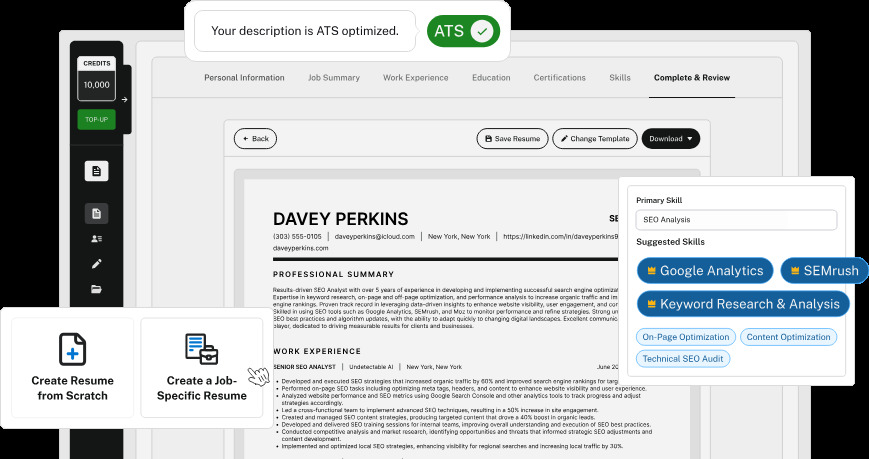
# 2 – Streamline Job Search with Auto Applier
Apply to multiple relevant positions efficiently. Our Smart Applier helps you in:
- Matching your experience with job requirements automatically
- Saving time while maintaining application quality
- Receiving alerts for positions matching your growth areas
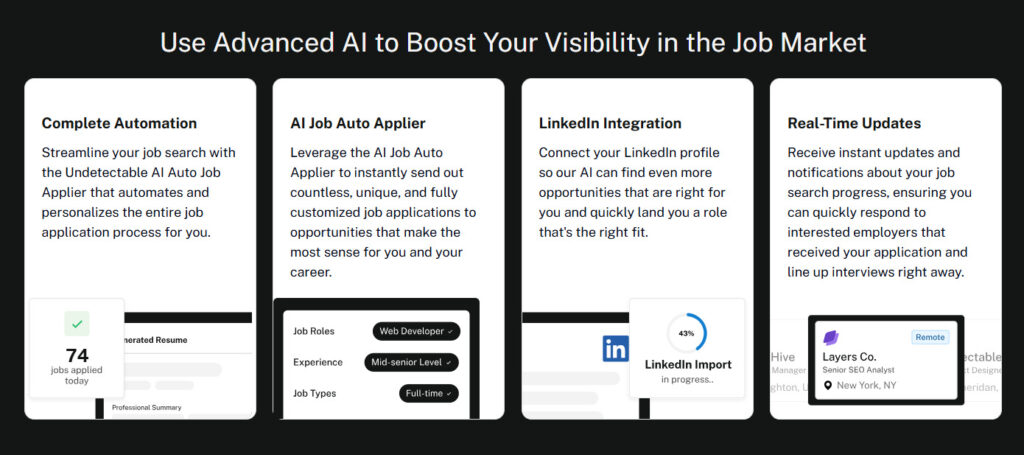
Tip: Use AI as a guide rather than a solution. Your authentic experiences and genuine growth story will always be more compelling than any AI-generated response.
Take advantage of our Resume Builder and AI Job Application Bot tools to increase your chances of landing interviews while presenting your professional development in the best possible light.
How to Match Your Weaknesses Answer to the Company Culture
To answer your weakness in the company’s culture, you first need to understand the company itself.
Start by studying the company’s website.
Study each and everything which includes, mission, value statements, team/culture pages, employee testimonials, recent news, blog posts, or anything you can get your hands on.
This research will give you a sense of the company’s culture, priorities, and overall vibe.
Next up, document each element in a notebook:
- Work style (collaborative vs. independent)
- Communication style (formal vs. casual)
- Decision-making approach (consensus vs. hierarchical)
- Innovation stance (risk-taking vs. conservative)
Once you’re done, align your weaknesses to fit the company’s culture.
Example:
- For fast-paced startups: I’ve been working on making quicker decisions without overanalyzing
- For collaborative environments: I’m developing my skills in gathering team input more effectively
- For traditional corporations: I’m improving my formal documentation processes
The Importance of Confidence in Delivering Your Response
Confidence is the key in an interview as this means you’re self-aware, have emotional intelligence, and professional maturity.
It not only establishes credibility, but also builds trust, and showcases that you have leadership potential.
For example:
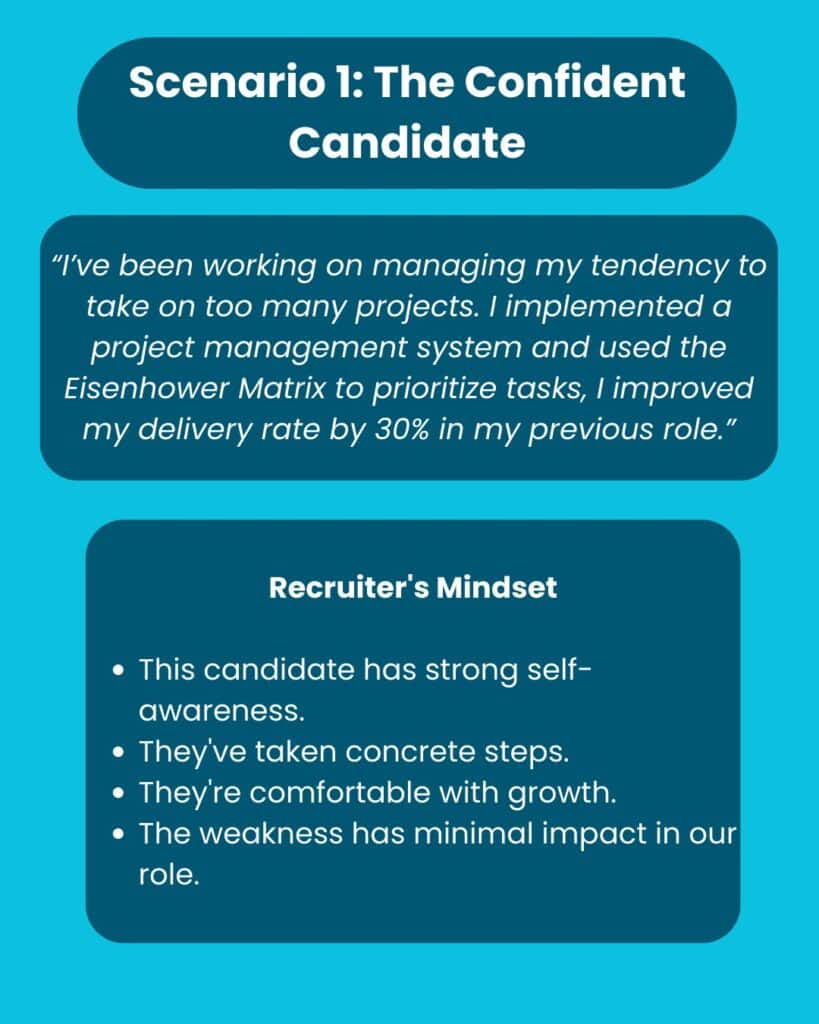
Scenario 2
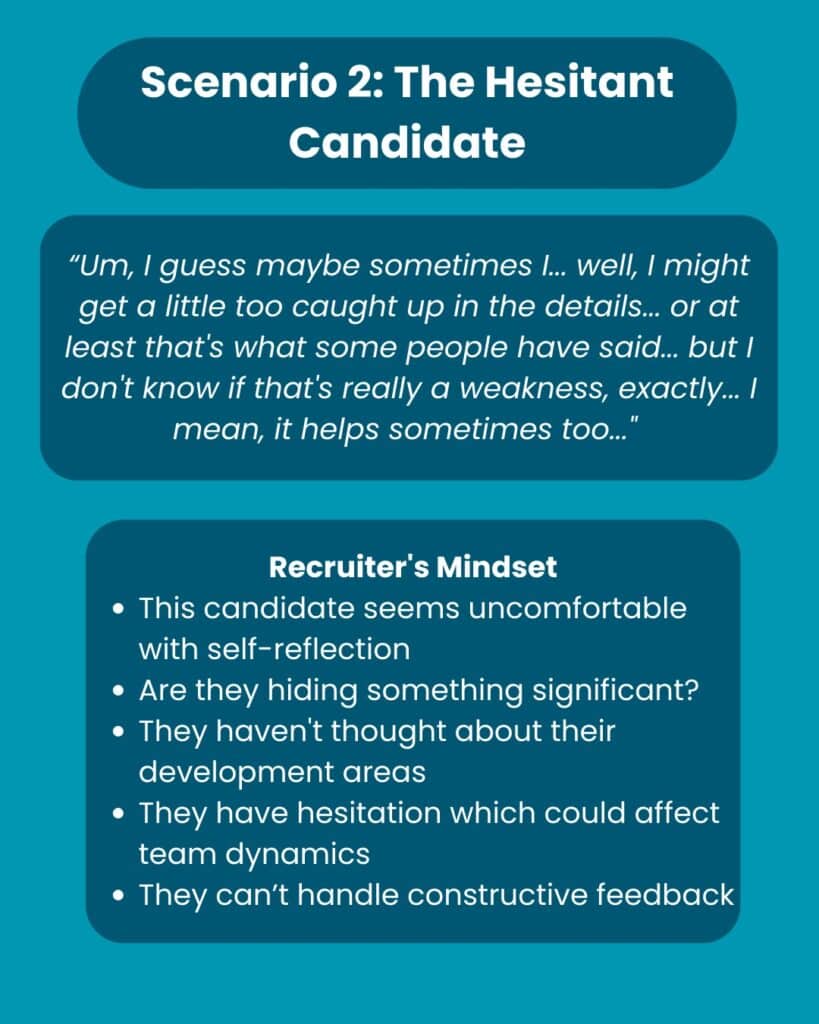
Consider yourself in the hiring manager’s position.
Whom are you likely to consider for the role? You know the answer!
That’s why confidence is the key and knowing how to build confidence is the most under-rated skill.
Explore our AI Detector and Humanizer in the widget below!
Conclusion
Remember, the best leaders aren’t those who lack weaknesses, but those who understand and actively work on them.
Your action step:
Before your next interview, schedule a “growth reflection hour.”
Sit down with a blank page and map out three instances where you faced
- Professional challenges
- What you learned
- How those lessons shaped your current approach to work.
This exercise will serve you throughout your career – try that.
And if anyone tells you they don’t have any weaknesses, they’re lying. (…even Superman had kryptonite, and he turned out pretty okay)
